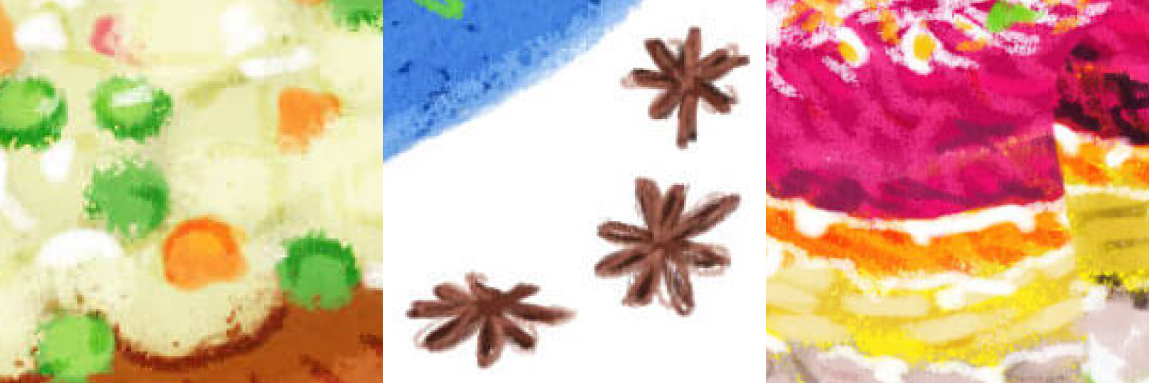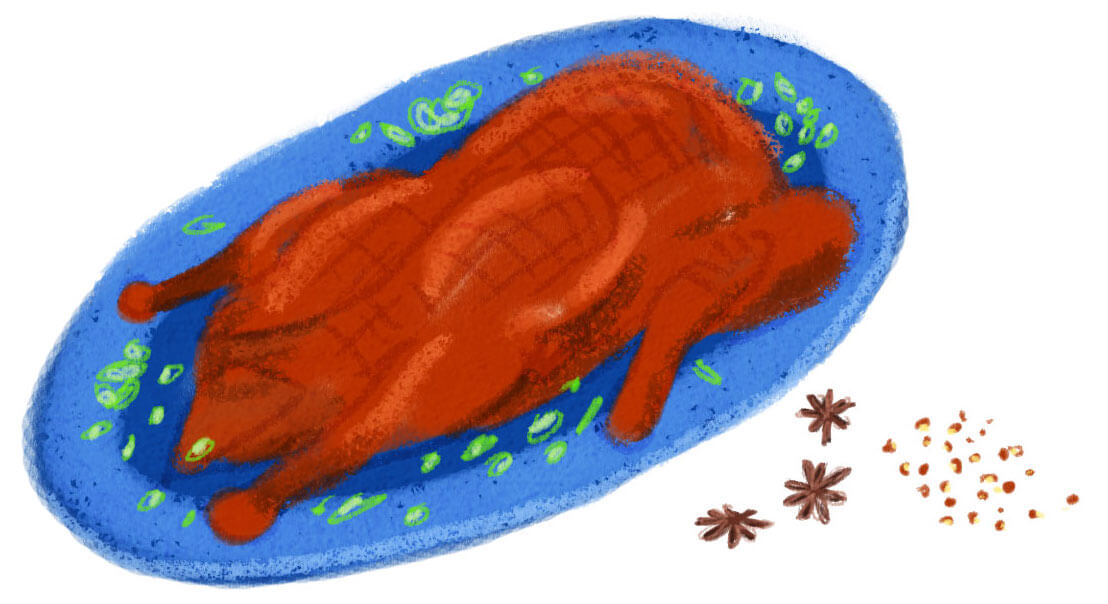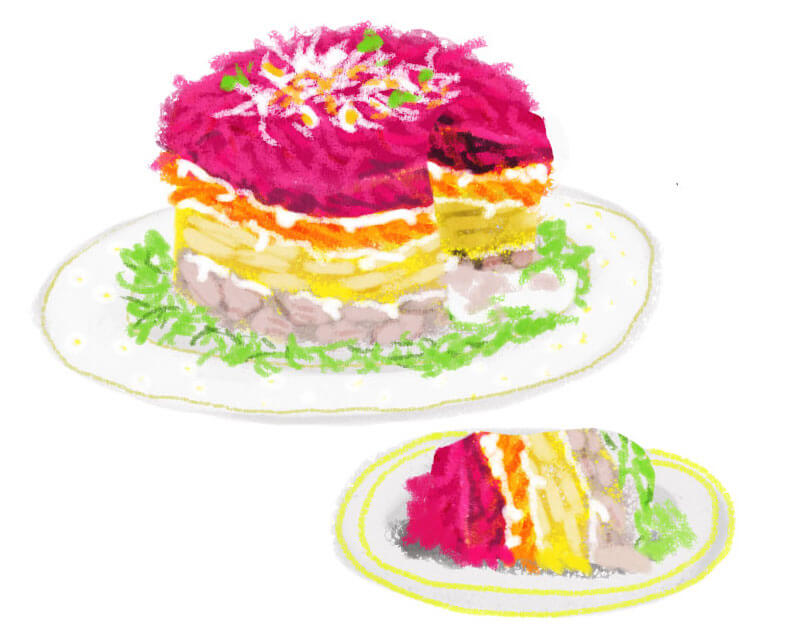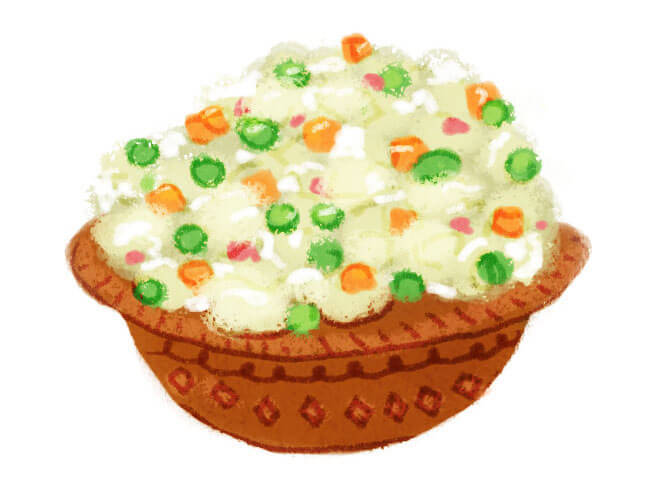Thanksgiving, from our tables to yours

It can be hard to think of things to be thankful for when all we hear about is the dying planet and the latest scandal embroiling our government. As immigrants (Julie was born in Beijing, China and Mariya in Tomsk, Russia), it's been especially tough to listen to detractors dismiss the accounts of dedicated first-generation and second-generation American public servants on the basis they were not "American enough." Nevertheless, this year, this year, we're thankful for our families and the ways we carve out places for our cultures to exist while celebrating the original immigrant holiday — Thanksgiving.
Each year, we braid together our old food traditions with new American ones and make them our own. We can take the elements we like about Thanksgiving (family, friends, the time to appreciate what we already have) and try to push back against the rest (colonialism, erasure of Native American lives and rights, and an ahistorical understanding of the holiday). From our Thanksgiving tables to yours: a few recipes our families make, to inspire you for a future Turkey Day when you’re finally tired of turkey or mashed potatoes!
Julie: A Chinese-American Thanksgiving in Texas
Each time I return to Dallas for Thanksgiving the highlight is the potluck. My family and the families of about seven of our friends (a homegrown surrogate extended family) gather in one house, and every family brings a few dishes. The ideal ratio of dishes and people is about 1:1.25, which makes for a jaw-dropping buffet. Someone will bring fish, which symbolizes abundance. There will invariably be some Chinese takeout classics like barbecue pork and drunken chicken. There’s always a fabulous array of vegetable dishes - stir-fried lotus root, chive dumplings, about five variations of tofu product (silken, firm, dried, fermented, just the papery skins knotted and braised, or stuffed then fried, or fried then stuffed), lots of garlicky greens. Dessert is usually store-bought pecan pie, homemade cakes, and sweet soups with red bean and sticky mochi or tapioca and coconut milk. One of the grown children, finally home but unfortunately politically corrupted by some liberal coastal city, might be volunteered to bring mashed potatoes for “American Dream” optics, even though it’s always left over. One family will be assigned to roast the turkey, but will rarely consider the gravy – the only reason to have turkey at all.
When turkey is optioned amidst such a feast, it makes for an utterly disappointing centerpiece. Its only redeeming factor is its silhouette. The breast is so stubbornly dry that you have to pull it out of the oven every thirty minutes to reintroduce it to its own fat. And it’s so comically heavy that when you take the carcass out, you’re simultaneously at risk of spraining your back, spilling hot drippings over your wrists, and dropping it before you get it to the counter. At that point, I’m always reminded that it’s just a dinosaur that has outlived its heydey. A manufactured nineteenth-century tradition monopolizing our tables, when tastier fowl were likely also present at the table in 1621.
Roast chicken is crispy, goose is rich, but the best is duck. It’s just big enough to feed a crowd without being unwieldy, and fatty enough to stay moist. Here’s my mother’s recipe for a jasmine tea smoked duck that she sometimes brings to the yearly potluck, if she’s feeling ambitious. The fat from the duck drips into the tea leaves and spices, and the whole bird comes out burnished and perfumed. It is complicatedly impressive, a true celebration dish. Like all Chinese recipes, it has next to no measurements. Apologies in advance, but I could not get more precise approximations out of my mom: “They’re just going to have to try it a couple times if they want to get it right,” she said.
Of course.
Recipe: Jasmine tea smoked duck

Ingredients:
- One whole roasting duck
- Salt
- Whole Szechuan peppercorns
- Rice, ground into a fine powder
- Loose-leaf jasmine tea (a cheap one!)
- Plain flour
- Brown sugar
- Two bay leaves
- One teaspoon whole cloves
- One dried tangerine peel or fresh peels from 5 clementines
- Two star anise
- Two dry red chili peppers (optional, should you want some heat)
- Honey for glazing
Step 1. Pat the duck dry and set aside. Combine 3 parts salt and 1 part whole Szechuan peppercorns in a dry pan, and toast until the salt is light brown, stirring frequently. The peppercorns will become fragrant. Take it off the heat to cool. Once cool, grind the salt and peppercorn mixture until peppercorns are finely ground and evenly distributed through the salt. Rub the mixture all over the duck, as well as inside the carcass. Place the duck in a container large enough to hold the duck and cover. Refrigerate overnight.
Step 2. The next day, preheat your oven to 400º Fahrenheit. Line a roasting tray with aluminum foil and oil a rack that fits into the tray. In the bottom of the roasting tray add equal parts ground rice, flour, jasmine tea leaves, and brown sugar. There should be enough to coat the bottom of the pan about half an inch. Add the spices and mix to combine. Put the oiled rack over the spiced rice and tea mixture. Place the dry-brined duck on the rack - the bottom of the duck should not touch the rice.
Step 3. Make a foil tent over the duck to form a smoking chamber. You’ll need a large piece of continuous foil that’s big enough to tent over the roasting tray so no air escapes. If you don’t have a large enough piece, fold the edges of multiple sheets together tightly to form a larger sheet. Tent the foil over the baking tray. Make sure that there’s plenty of room in the tent; there should be space between the foil and the duck. Then press the foil around the edge of the roasting tray and seal tightly.
Step 4. Roast for 3 hours, but adjust based on how hot your oven runs. Once cooked, take the bird out, remove the smoking tent, brush honey over duck and broil on high for 3-5 minutes to crisp the skin. Let the duck rest for 15 minutes before carving.
Mariya: A Russian-American Thanksgiving in the PNW
1
Every year, my family hosts Thanksgiving for a large group of friends — mostly Russian immigrants like us. The table heaves with main dishes and side dishes because we've gone with the strategy of making two full meals and jamming them together instead of Americanizing Russian dishes or Russifying American ones. Russian winter salads and all manner of open-faced toasts mingle with turkey, stuffing, and mashed potatoes.
I've always been the most aesthetically interested in Shuba salad, a root vegetable and pickled fish bonanza with rainbow layers. It's a traditional New Year's dish in Russia and other former Soviet states, and holiday tables don't look correct without it to me. Shuba is a perfect marriage: so cheerful and fanciful with its vibrant colors, but so practical, filling, and creamy in a long, cold winter with its reliance on root vegetables and mayo. There's discomfort and anxiety in feeling different, so this was not a dish I invited my friends to try growing up, but I'm coming around to it. It reminds me a little of Rachel's trifle in Friends. Potatoes…good. Beets…good. Herring…good? Mayo-based dishes can be a little controversial, but the older I get, the more I want to eat them.
It was my job to peel the vegetables, the large, colorful shapes of the cooked potatoes, beets, carrots, and eggs cooling together on a plate, ready to be turned into color-coordinated piles of Lego-sized pieces and then layered. For the pièce de résistance, the magenta of the beets blends with the white mayo to create thea pink fluffy blanket on top that is this salad’s namesake (shuba means “fur coat”).
Recipe 1: Shuba Salad

Ingredients:
- 4 fillets pickled herring
- 1 onion
- 3 medium beets
- 3 large potatoes
- 2 carrots
- 2 eggs
- 1 cup mayonnaise
- Salt
Step 1: Boil the potatoes, carrots, beets, and eggs in a large pot until fully cooked and easily pierced with a knife. Remember that the eggs and carrots will take less time to cook than the potatoes and beets.
Step 2: Grate the potatoes, carrots, eggs, and raw onion into separate piles using a box grater. Dice the herring into small pieces.
Step 3: Layer the ingredients in a serving dish to create the salad, starting with a layer of herring, followed by a layer of onion, then a layer of potato, a layer of mayonnaise, a layer of eggs, and a layer of carrots.
Step 4: The final layer is made of beets with a coating of mayonnaise on top to create a vibrant pink color.
(Adapted from: Dressed Herring )
2
Another staple of Russian New Year's meals, Olivier salad features perfect cubes of multicolored vegetables in a mayonnaise dressing. Bright color is a theme here, as is mayo. Essentially this is a potato salad, but in my mind's categories it lives so far away from summer 4th of July potato salad that I was surprised when I saw it being referred to as such in a recipe online. This dish is simply called Russian Salad in some places (I saw it on a few restaurant menus in France as "salade russe"), so its PR campaign as a Russian staple has been strong.
Recipe 2: Olivier Salad

Ingredients:
- 5 medium potatoes
- 4 or 5 hot dogs or diced ham
- 5 pickles
- 2 carrots
- 1 can of peas
- 4 eggs
- 1 onion
- Mayonnaise to taste (3/4 cup?)
- Salt
Step 1: Boil potatoes and carrots until fully cooked and easily pierced with a knife. Hardboil the eggs and simmer hot dogs until fully cooked.
Step 2: After the vegetables and eggs have cooled to room temperature, peel them.
Step 3: Dice the potatoes, carrots, eggs, hot dogs, pickles, and raw onion into equal cubes.
Step 4: Gently stir together with the mayo, salt, and canned peas.
Despite the reservations some people (rightly) have about the history of Thanksgiving and what it represents, an encouraging thread of hope stands out in the narrative: Thanksgiving was a gathering of immigrants. Just as our parents over the years have resorted to readily available grocery store substitutes for what would have been staples in China or Russia, the Pilgrims tried their best to recreate a familiar feast to celebrate a long-awaited harvest.
Now centuries later, when the holiday food has become steeped in tradition and recycled year after year, we forget how alien the first Thanksgiving must have felt to the Plymouth settlers. With none of the basic English staples of beer, bread, or butter, the recently-arrived Europeans sat down gratefully to plates full of unfamiliar ingredients like squash, pumpkins, corn, wild berries, and lobster. It was as much a meal to toast a new beginning in a new land as it was to reminisce at year’s end.
So with that, we hope you’ll bring back some of this original wonder to your Thanksgiving tables with some new foods, be it pickled herring in a fluorescent salad or smoked tea under any other bird but a turkey. It’s probably too late this year, but the good thing about Thanksgiving is that it comes back around every twelve months. Otherwise, these recipes are equally good for the rest of the holiday season, the new year, or your next dinner party.